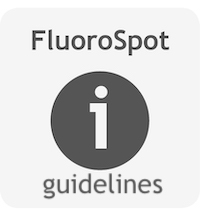Troubleshooting FluoroSpot assay
What seems to be the problem?
- High background or artificial spots
- Confluent spots or poorly defined spots
- Faintly stained or no spots in positive controls
- Low spot frequency
- Small spots
- Large spots
- Poor consistency of replicates
- Blank areas
- High spot frequency in negative controls
My question is not mentioned here, how can I contact U-CyTech?
Notes:
RT: room temperature; temperature between 20 °C and 26 °C
To abbreviations
I am experiencing a high background or artificial spots in the FluoroSpot wells. What could have happened?
High background can be due to a high background staining, autofluorescence or to too many spots. There could be various reasons:
- Inadequate washing: follow the “Directions for washing” carefully.
- Nonspecific binding: serum used in the culture medium should be selected on low background staining (since it might contain, for example, heterophilic antibodies that cross-link the coating and detection antibodies used in the FluoroSpot assay).
- Contaminated working solutions or cell culture: solutions should not be used when they have become turbid or an indication of bacterial or fungal growth. Use clean containers/pipet tips for the transfer of solutions into the wells of the FluoroSpot plate.
- Carryover of secreted proteins (i.e. cytokines) produced during preincubation step: ensure effective washing of collected cells after preincubation and before adding cells to the FluoroSpot plate. See: "Cell sample preparation".
- Incomplete drying of PVDF membranes after completion of the FluoroSpot assay: allow the PVDF membranes to dry completely (protected from light) prior to spot counting.
- Too many cells in the FluoroSpot well: decrease the cell concentration in the wells of the FluoroSpot plate by making some dilutions that will result in formation of distinct spots (optimally 50-250 spots/well).
- Improper incubation period of cells in the FluoroSpot plate: decrease incubation time of cells in the FluoroSpot plate or follow the procedure with a preincubation step.
- Wrong type of PVDF membrane-bottomed plate: FluoroSpot plates with the IPFL PVDF membrane from Millipore, that are provided with the kit, are selected for low background fluorescence. Do not use other type of plates.
- Incorrect plate reader contrast settings: adjust the settings that give the appearance of high background and reread the plate.
- Dust particles: prior to spot counting, remove autofluorescent dust particles by blowing compressed air (4-5 bar) into the wells.
The spots I see are poorly to define or confluent. What went wrong?
There could be several reasons for confluent or poorly defined spots:
- Too many cells in the FluoroSpot well: decrease the cell concentration in the wells of the FluoroSpot plate by making some dilutions that will result in formation of distinct spots (optimally 50-250 spots/well).
- Improper incubation period of cells in the FluoroSpot plate: decrease incubation time of cells in the FluoroSpot plate or follow the procedure with a preincubation step.
- Moving FluoroSpot plate during cell incubation: prevent the plate from being moved during the cell incubation step. Even minor vibrations (e.g. closing the door of the incubator) can affect spot formation. Make sure the incubator is leveled.
- Dust particles: prior to spot counting, remove autofluorescent dust particles by blowing compressed air (4-5 bar) into the wells.
The spots I see are faint or I find no spots at all in my positive controls. What went wrong?
Finding no spots at all in the positive controls suggest a problem with the cells or the assay did not work properly. Faintly stained spots can be due to a problem that occurs during the assay procedure. Several causes could be the reason of no spots or faintly stained spots:
- Reduced viability of cells: check the viability of the cells before using in the FluoroSpot procedure, especially when using cryopreserved and thawed cells. Ensure the period between blood draw and PBMC or spleen cells isolation is as short as possible (preferably less than 8 h). See directions for “Cell collection and handling”.
- Use of an unsuitable stimulus or stimulus concentration: a suitable stimulus should be determined experimentally. Test different stimuli and ensure a proper stimulus concentration. Check "Guidelines for stimuli".
- Use of unstable ionomycin: ionomycin stock should be stored protected from light at -20 °C. For short term use the reagent is stable up to 4 weeks when kept sterile and stored protected from light.
- Use of PBS tablets for preparing coating antibody solution: the filler in tablets interferes with the coating process. Use sterile liquid ready-to-use PBS instead. Thermo Fisher Scientific cat. no. 10010 is recommended.
- Degradation of antibodies: follow recommended storage conditions. Ensure the detection antibodies are protected from light.
- Degradation of conjugate: follow recommended storage conditions. Ensure protection from light. Do not freeze.
- Improper antibody or conjugate solution: ensure appropriate dilution of antibodies and conjugate.
- Incorrect incubation times, temperature or conditions: ensure correct incubation times and temperature of the FluoroSpot reagents. Reagent solutions should be at RT before use. Ensure the detection antibodies and conjugate are incubated protected from light. Check function of the CO2 incubator (37 °C, 100% humidity, 5% CO2). Optimal cell incubation times should be determined experimentally. Test different incubation times. Check "Guidelines for cell incubation".
- Photobleaching of spots: store FluoroSpot plates at RT at a dry place protected from light. Spots from the FluoroSpot assay suffer from photobleaching. Although the spots are stable for several weeks to months (when plates are stored as advised), it is recommended to evaluate the FluoroSpot plate within a week after completion of the assay. Repeated expose during evaluation (for example, while setting up an automated reader) will also lead to photobleaching of spots.
- Incorrect plate reader settings: adjust the settings and reread the plate.
- Omitting prewetting step: it is important to prewet the hydrophobic PVDF membrane with ethanol to assure optimal binding of the coating antibodies to surface.
- Drying out of the PVDF membrane: do not allow the PVDF membrane to dry during the procedure. If this occurs directly after prewetting, repeat prewetting step. Further on in the procedure: always keep the membrane wet, if necessary with PBS or wash buffer.
- The underdrain of the ELISPOT plate has not been removed: remove and discard underdrain after the detection antibody incubation step and wash both sides of the PVDF membrane in each wash step thereafter.
- At some step no reagent was added: check the liquid level of all wells after adding new reagent.
- Incomplete drying of PVDF membranes after completion of the FluoroSpot assay: allow the PVDF membranes to dry completely (protected from light) prior to spot counting.
I am getting a low frequency of spots. What could have happened?
There could be several reasons for low spot frequency:
- Clumping of cells: resuspend cells gently but thoroughly, to gain a homogeneous cell suspension, before the cells are transferred into the wells of the FluoroSpot plate.
- Reduced viability of cells: check the viability of the cells before using them in the FluoroSpot procedure, especially when using cryopreserved and thawed cells. Ensure the period between blood draw and PBMC or spleen cells isolation is as short as possible (preferably less than 8 h). See directions for “Cell collection and handling”.
- Too many activated granulocytes present before PBMC isolation: the maximum time period between blood draw and PBMC isolation should be 8 h.
- Cell concentration in FluoroSpot wells is too low: increase the cell concentration in the wells of the FluoroSpot plate. Make several dilutions of cells to find the optimal dilution of cells resulting in formation of distinct spots (optimal: 50-250 spots/well). Cell numbers do show linearity due to the need of optimal cell-cell contact. Do not add more than 3x105 cells/well, because cells will cause multiple cell layers, resulting in poor spot formation.
- Inadequate incubation time of the cells: determine the optimal (pre)incubation time of the cells by increasing or decreasing the (pre)incubation time.
- Use of unstable ionomycin: ionomycin stock should be stored protected from light at -20 °C. For short term use the reagent is stable up to 4 weeks when kept sterile and stored protected from light.
- The underdrain of the ELISPOT plate has not been removed: remove and discard underdrain after the detection antibody incubation step and wash both sides of the PVDF membrane in each wash step thereafter.
The spots I see are all small. What went wrong?
There is one mean reason for small spots:
- Inadequate incubation time of cells: prolong incubation time of the cells on FluoroSpot plate.
The spots I see are all large. What went wrong?
There is one mean reason for large spots:
- Inadequate incubation time of cells: shorten incubation time of the cells on FluoroSpot plate.
I am experiencing a poor consistency of replicates between the FluoroSpot wells. What could have happened?
There are several reasons for a poor consistency of replicates:
- Inaccurate pipetting: ensure accurate pipetting volume. Check pipettes.
- Clumping of cells: resuspend cells gently but thoroughly, to gain a homogeneous cell suspension, before the cells are transferred into the wells of the FluoroSpot plate.
- Evaporation of solutions: ensure adequate humidity. Check function of the CO2 incubator (37 °C, 100% humidity, 5% CO2). Ensure accurate sealing of the plate.
- Inaccurate temperature distribution during incubation steps: do not stack the plates during incubation.
- Inadequate washing: follow the “Directions for washing” carefully.
- At some step no reagent was added: check the liquid level of all wells after adding new reagent.
I see blank areas in between the spots. What went wrong?
There are various reasons for blank areas:
- Cells are unevenly distributed: resuspend cells gently but thoroughly, to gain a homogeneous cell suspension, before the cells are transferred into the wells of the FluoroSpot plate. Do not add any solution once the cells are in the wells of the FluoroSpot plate.
- Damage of the coating layer: ensure not to scratch the bottom of the well with a pipet tip.
- Inaccurate prewetting of the PVDF membrane: do not allow the PVDF membrane to dry during the procedure. If this occurs directly after prewetting, repeat prewetting step.
- Foam forming during washing: the spout of the squirt bottle may be too narrow and should be enlarged.
- The underdrain of the ELISPOT plate has not been removed: remove and discard underdrain after the detection antibody incubation step and wash both sides of the PVDF membrane in each wash step thereafter.
I am experiencing a high frequency of spots in the negative controls. What could have happened?
Finding a high number of spots (i.e. ≥ 30 spots/well when working with 2x105 cells/well) in the negative controls suggest that either the cells spontaneously secrete the analyte (i.e. cytokine) of interest or the assay did not work properly. Several reasons could explain a high frequency of spots in the negative controls:
- Spontaneously secreting cells cannot always be prevented. For example, adherence of monocytes/macrophages in the PBMC sample to the surface of an FluoroSpot well may already be sufficient to trigger TNF-α and IL-6 release. Also, the immune system of the donor can be active without us realizing it.
- False positive results due to reagents or cell culture media: reagents and cell culture media ingredients, like serum, should not trigger cells. New medium (ingredients) or serum should be checked first in the FluoroSpot assay before using it with samples. Check whether the background control (no cells added but all other reagents) has no spots. When this is not the case, one or more of the used reagents is causing false positive results. When the background control is negative, one or more of the used reagents might trigger the cells to secrete the analyte without using any extra stimuli (for example, when a reagent is contaminated with LPS or serum that contains triggering factors for the cells).
- Inaccurate cell collection and handling. See: "Cell collection and handling" for our guidelines.
My question is not mentioned here, how can I contact U-CyTech?
The researchers of U-CyTech build on years of experience in the development and performance of FluoroSpot assays for human and monkey species. They are be more than happy to help you with additional advice and to share their experiences.
Please contract our customer service:
E-mail: cs @ ucytech.com
(back to top or to FluoroSpot assay guidelines)
Note:



